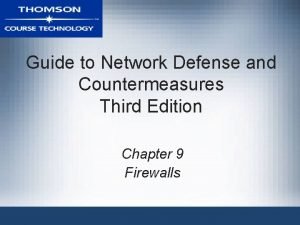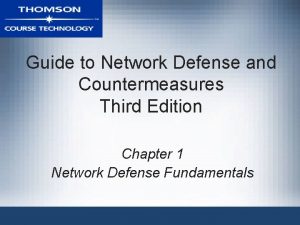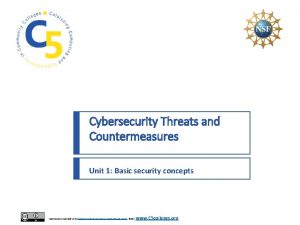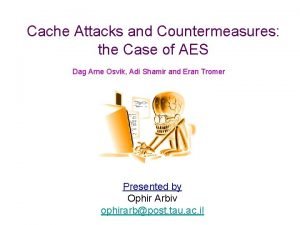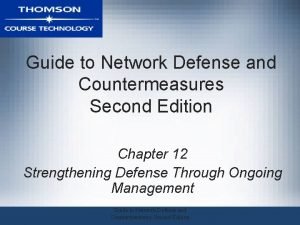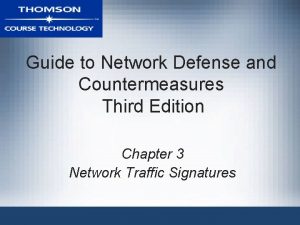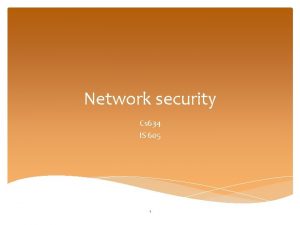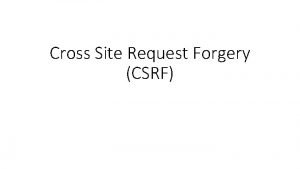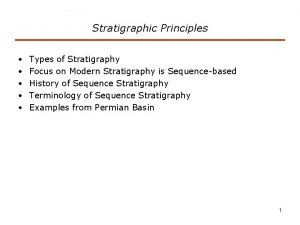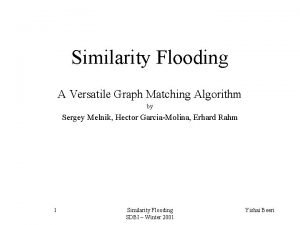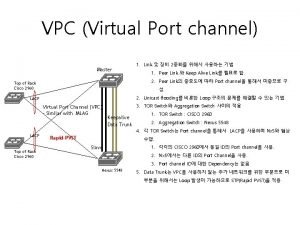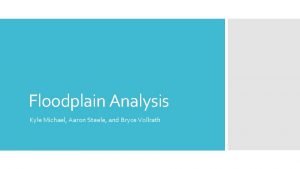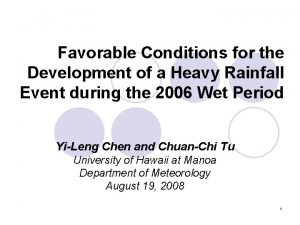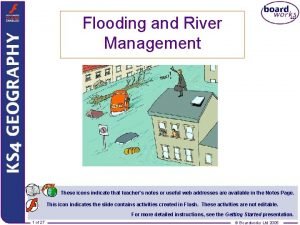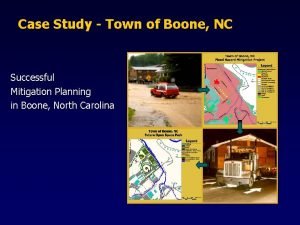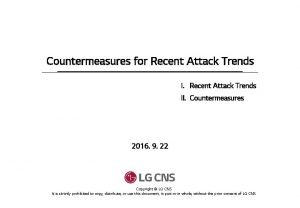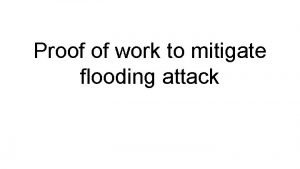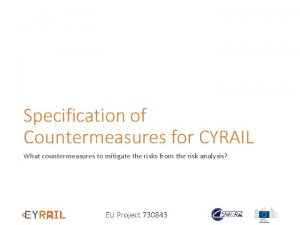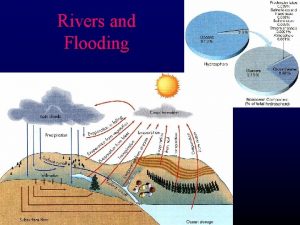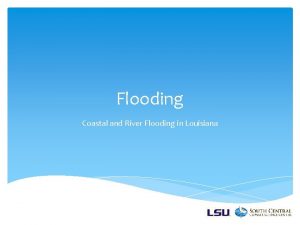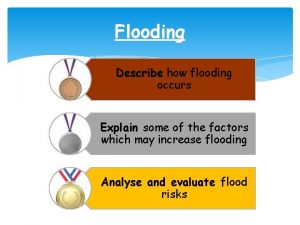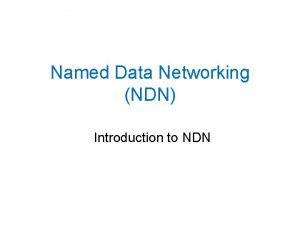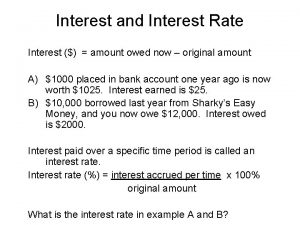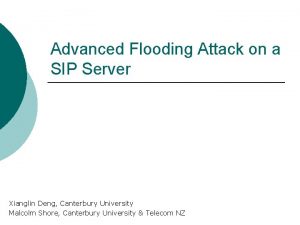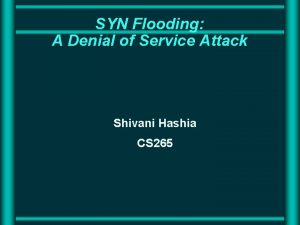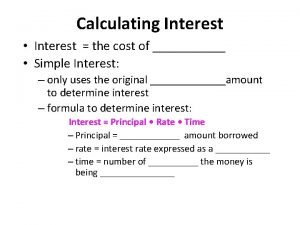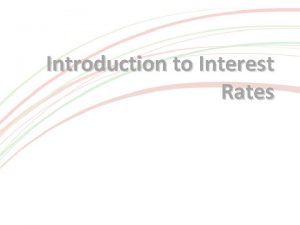Interest Flooding Attack and Countermeasures in Named Data




































- Slides: 36

Interest Flooding Attack and Countermeasures in Named Data Networking Authors: Alexander Afanasyev, Priya Mahadevany, Ilya Moiseenko, Ersin Uzuny, Lixia Zhang Publisher: IFIP Networking, 2013 (International Federation for Information Processing) Presenter: Chia-Yi, Chu Date: 2013/11/27 1

Outline � Introduction � NDN Overview � Interest Flooding Attacks in NDN � Interest Flooding Mitigation Methods � Evaluation of Interest Flooding Mitigation Methods 2

Introduction (1/1) � Provides 3 mitigation algorithms to mitigate Interest flooding � Interest flooding ◦ malicious users can attack the network by sending an excessive number of Interests. Since each Interest consumes resources at intermediate routers as it is routed through the network, an excessive number of Interests can congest the network and exhaust a router’s memory. 3

NDN Overview (1/2) � A receiver-driven, data-centric communication protocol � Communications in NDN are performed using two distinct types of packets ◦ Interest and Data. � Both types of packets carry a name ◦ which uniquely identifies a piece of content that can be carried in one Data packet. � content name is composed of one or more variable- length components and be delimited by “/”. ◦ youtube video would look like: “/youtube/videos/0 F 8 Ydlk. KO 9 A/0”. 4

NDN Overview (2/2) � NDN routers maintains three major data structures: ◦ Pending Interest Table (PIT) �holds all “not yet satisfied” Interests that have been sent upstream towards potential data sources. ◦ Forwarding Interest Base (FIB) �maps name prefixes to one or multiple physical network interfaces, specifying directions where Interests can be forwarded. . ◦ Content Store (CS) �temporarily buffers Data packets 5

Interest Flooding Attacks in NDN (1/4) � Interest packets in NDN are routed through the network based on content name prefixes and consume memory resources at intermediate routers. � An attacker or a set of distributed attackers can inject excessive number of Interests in an attempt to overload the network and cause service disruptions for legitimate users � A large volume of such malicious Interests can disrupt service quality in NDN network in two ways: create network congestion and exhaust resources on routers. 6

Interest Flooding Attacks in NDN (2/4) 7

Interest Flooding Attacks in NDN (3/4) � if the data producer is the exclusive owner of “/foo/bar” namespace, both router B and the data producer would receive all Interests for “/foo/bar/. . . ” that cannot be otherwise satisfied from in-network caches. � An excessive amount of malicious Interests can lead to exhaustion of a router’s memory ◦ NDN routers maintain per-packet states for each forwarded Interes 8

Interest Flooding Mitigation Methods (1/15) � Naïve solution ◦ restrict the number of Interests forwarded through the network. � Simplementation technique ◦ To limit the number of forwarded Interests out of each interface based on the physical capacity of the corresponding interface. ◦ a slight modification of the well-known Token Bucket algorithm 9

Interest Flooding Mitigation Methods (2/15) � 10

Interest Flooding Mitigation Methods (3/15) ◦ Drawbacks �result in underutilization of the network �not all Interests will result in a Data packet �can nourish DDo. S attacks �If a router has utilized all its tokens to forward malicious Interests, it can no longer forward incoming Interests from legitimate users till the pending malicious Interests start to expire ◦ Solution �impose a per interface fairness 11

Interest Flooding Mitigation Methods (4/15) � Token bucket with per interface fairness ◦ extend the Pending Interest Table ◦ to support flagging of Interests that cannot be immediately forwarded and implement hierarchical queues for each interface ◦ not actually store a packet, but merely a bi-directional pointer to the existing PIT entry. 12

Interest Flooding Mitigation Methods (5/15) 13

Interest Flooding Mitigation Methods (6/15) 14

Interest Flooding Mitigation Methods (7/15) � Token bucket with per interface fairness ◦ Drawback �still admits a relatively large number of Interests from malicious users �it drops both legitimate and malicious Interests �attempts to ensure that each interface does not forward more than its fair share of Interests ◦ Solution �be able to detect and differentiate to some extent malicious requests from legitimate ones. 15

Interest Flooding Mitigation Methods (8/15) � 16

Interest Flooding Mitigation Methods (9/15) 17

Interest Flooding Mitigation Methods (10/15) 18

Interest Flooding Mitigation Methods (11/15) � 19

Interest Flooding Mitigation Methods (12/15) 20

Interest Flooding Mitigation Methods (13/15) � Satisfaction-based pushback ◦ enable and enforce explicit Interest limit for each incoming interface, where the value of the limit depends directly on the interface’s Interest satisfaction ratio. ◦ Announce these limits to their downstream neighbors ØAny Interest forwarded from the downstream router is allowed to get through, resulting in genuine Interest satisfaction statistics. 21

Interest Flooding Mitigation Methods (14/15) 22

Interest Flooding Mitigation Methods (15/15) 23

Evaluation of Interest Flooding Mitigation Methods (1/13) � Use the open-source ndn. SIM package ◦ implements NDN protocol stack for NS-3 network simulator � token bucket with per interface fairness � satisfaction-based Interest acceptance � satisfaction-based pushback � To quantify the effectiveness of algorithms ◦ percentage of satisfied Interests for legitimate users. ◦ A high percentage of user-expressed Interests are satisfied even while the network is under attack 24

Evaluation of Interest Flooding Mitigation Methods (2/13) � Simulations on two different network topologies ◦ Smaller binary tree topology ◦ Larger ISP-like topology � The percentage of attackers in the network ◦ Ranged from 6% attackers to over 50% attackers � Delay ◦ binary tree topology: 80 ms ◦ ISP-like topology: 330 ms � Data size ◦ 1100 bytes 25

Evaluation of Interest Flooding Mitigation Methods (3/13) � Small-scale evaluations ◦ There are 16 end users �both legitimate and attackers ◦ Each expressing Interests that are routed towards a single data producer �placed at the root of the tree. ◦ Bandwidth of 10 Mbps ◦ Randomized propagation delay ranging from 1 to 10 ms. 26

Evaluation of Interest Flooding Mitigation Methods (4/13) 27

Evaluation of Interest Flooding Mitigation Methods (5/13) � Effectiveness of the three mitigation algorithms ◦ Perform 10 independent simulation runs ◦ 7 client nodes to represent adversaries, 9 client nodes represent legitimate users �where randomly choose ◦ 10 -minute attack window �Total simulation time was 30 minutes 28

Evaluation of Interest Flooding Mitigation Methods (6/13) 29

Evaluation of Interest Flooding Mitigation Methods (7/13) � Network reaction to varying number of attackers ◦ vary the percentage of attackers in the topology from 6% to over 50%. ◦ as the number of attackers increases, the number of legitimate users decreases ◦ All other parameters and experimental setup are consistent with the previous experiment 30

Evaluation of Interest Flooding Mitigation Methods (8/13) 31

Evaluation of Interest Flooding Mitigation Methods (9/13) � Large scale simulations ◦ based on a modified version of Rocketfuel’s AT&T topology ◦ extracted the largest connected component �comprising of 562 nodes ◦ separated the nodes into three categories 1. Clients �Having degree less than four 2. Gateways �directly connected to clients 3. Backbones �the remaining nodes 32

Evaluation of Interest Flooding Mitigation Methods (10/13) 33

Evaluation of Interest Flooding Mitigation Methods (11/13) ◦ Assigned bandwidth and delay values to links based on their type 34

Evaluation of Interest Flooding Mitigation Methods (12/13) ◦ placing the data producer at both a gateway node as well as backbone node ◦ fixed the number of malicious nodes at approximately 40% � 140 out of 344 client nodes in the topology ◦ the attack duration spanning a 5 -minute interval. 35

Evaluation of Interest Flooding Mitigation Methods (13/13) 36
 Guide to network defense and countermeasures
Guide to network defense and countermeasures Guide to network defense and countermeasures
Guide to network defense and countermeasures Cyber security threats and countermeasures
Cyber security threats and countermeasures Cache attacks and countermeasures: the case of aes
Cache attacks and countermeasures: the case of aes Operational auditing
Operational auditing Ark ping
Ark ping Active attack and passive attack
Active attack and passive attack Passive attack and active attack
Passive attack and active attack Csrf countermeasures
Csrf countermeasures Spill prevention control & countermeasures training
Spill prevention control & countermeasures training What is real interest rate and nominal interest rate
What is real interest rate and nominal interest rate Compound interest multiplier
Compound interest multiplier Nominal interest rate
Nominal interest rate Advantages and disadvantages of floods
Advantages and disadvantages of floods Exxon slug model
Exxon slug model Similarity flooding
Similarity flooding Flooding therapy
Flooding therapy Tornado impact on ecosystem
Tornado impact on ecosystem Flooding therapy example
Flooding therapy example Advanced emotional intelligence
Advanced emotional intelligence Core flooding experiments
Core flooding experiments Onion creek flooding
Onion creek flooding Vpc vs lacp
Vpc vs lacp Kure beach flooding
Kure beach flooding Watseka il flooding
Watseka il flooding Kahala mall flooding
Kahala mall flooding General alarm in ship
General alarm in ship Flooding in key west
Flooding in key west Bangladesh floods case study
Bangladesh floods case study Schuylkill river flooding today
Schuylkill river flooding today Flooding icons
Flooding icons Titanic starboard side
Titanic starboard side Costal flooding
Costal flooding Boone nc flooding
Boone nc flooding Flooding barriers
Flooding barriers Urbanization flooding
Urbanization flooding Token economy psychology
Token economy psychology
